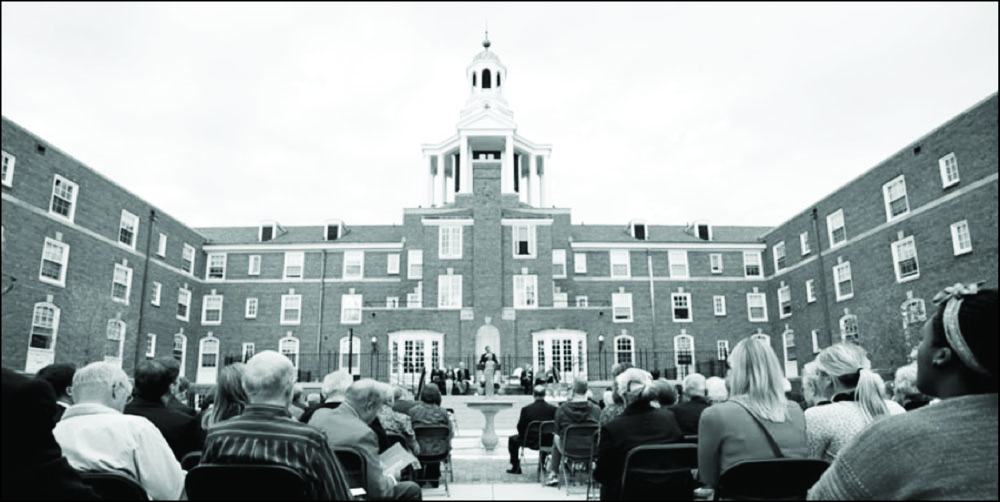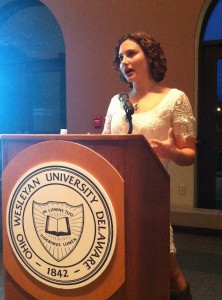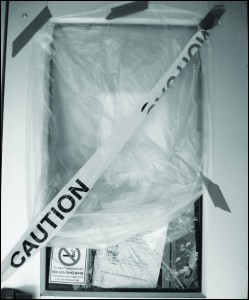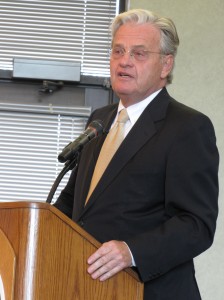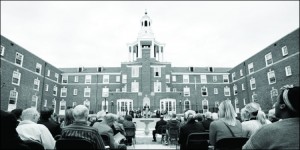
By Rachel Vinciguerra
Transcript Correspondent
After 15 months of renovations Stuyvesant Hall officially opened its doors last Friday as current students, faculty, trustees, alumni and Ohio Wesleyan parents participated in this historic event.
David Chambliss, development officer of university relations, said they invited alumni and friends who had supported the Stuyvesant Renovation, and he noticed Ohio Wesleyan alumni from all over the country in attendance.
Stuyvesant was open to guests and visitors from 3:30 to 5:30 p.m. Fifteen minutes before the ceremony ended, the Owtsiders, Ohio Wesleyan’s co-ed a capella group, performed. They began their set with the Alma Mater.
Thomas Stratton, a grandparent of a current student, said his family was drawn to this event by the music, but stayed for the dedication after seeing the architecture of the building.
“This impression is similar to my impression of colonial Williamsburg,” Stratton said.
President Rock Jones also acknowledged the traditional feel of the building.
“Stuyvesant bears all the history of a building in the 1920s, but now with all the amenities of the 21st century,” Jones said.
The dedication ceremony began with the hymn “When All Thy Mercies, O My God.” It played on the restored carillon, just as it had at the first dedication ceremony in 1931.
Michael Long, the chair of the Board of Trustees, began the speeches.
“‘It’s a great day to be a Bishop,’” Long said, quoting Evan Corns. “There are over 80 years of memories in this place and there will be new memories as precious to today’s students as ours are to us.”
Throughout the ceremony, memories of the old Stuyvesant were shared.
Jones spoke some of the history of Stuyvesant’s original construction.
He said Frank Stuyvesant and his wife had learned about Ohio Wesleyan from their neighbor’s daughter, who attended school here. They were impressed by the education she was receiving, but not by the housing available for women at the time.
“They took an interest and wanted to share their sources,” Jones said.
These sources represented the largest financial commitment to the university until that time. For the next 40 years Stuyvesant served as the female dorm for first-year women.
Jones asked all the women in attendance who had lived in Stuyvesant during that time to raise their hands. Nearly 30 raised hands could be seen across the courtyard.
Alumni who remembered those 40 years shared their memories of Stuyvesant before, after and during the ceremony.
“I imagine that Gordon Crider Smith was one of those fraternity men who would croon outside the windows, singing to the women of Stuyvesant,” Jones said.
Helen Crider Smith ‘56, a donor for the restoration, said she remembered living in Stuyvesant during that time.
“Nostalgia played a part in our wanting to renovate,” Smith said.
She spoke about life in Stuyvesant Hall.
“We had to be in by 8:10 p.m. on weekdays, including Friday,” she said.
“There was even a night watchman, we called ‘Pop,’ who made notes of which lights were on after 11 p.m.
She said she really came to understand how respected Ohio Wesleyan was when she worked as an assistant to an English professor at Harvard University who had heard good things about OWU.
“That understanding of how important our school was in the country really made me appreciate what Ohio Wesleyan has done for me,” Crider Smith said.
“We sense that current students are just as proud of their education as we were.”
Gordon Crider Smith ‘54, a donor for the restoration, gave a message to current students.
“As time progresses during your lifetime, Stuyvesant will age and need renovation again,” he said.
“Remember this day when time delivers you to your 70s and 80s, I promise it is closer than you think.”
Gordon Crider Smith encouraged current students to take on what he called “the $100 challenge.”
He said if current students would invest just $100 now they will be able to give back thousands more by the time Stuyvesant needs renovation again.
“We will have gone away, but remember us and the $100 challenge we put before you,” he said.
Gordon and Helen Crider Smith gave a similar challenge to Jones last year when they donated thousands of dollars to the renovation efforts.
“We had to meet their donation within 90 days so that construction could begin in the summer of 2011,” Jones said.
A similar proposal was made in 1925 when Stuyvesant was being constructed for the first time, Helen Crider Smith said.
“The original proposal for Stuyvesant had a stipulation that the money would be matched in five years,” she said.
“They did not give us that much time. But we are glad we could complete the task,” Jones said.
Jones went on to thank alumni, students and trustees.
“We’ll benefit from your vision, your philanthropy and your generosity,” he said.
Senior Iftekhar Showpnil, a residential assistant in Stuyvesant Hall, spoke on behalf of the students at the ceremony.
He said he lived in Stuyvesant both before and after the renovation.
“Stuyvesant was not the first choice on anyone’s list before the renovations,” he said.
But even then, he said, there was a sense of community unique to the building.
“I’ve seen people laugh in joy and share their sorrows here. Stuyvesant is more than a building, it’s a community,” Showpnil said.
He called Stuyvesant his “home away from home.”
Senior Allyson North said she came to the ceremony because she appreciated the appearance of the building.
“I love the architecture, and it does give a sense of home and tradition,” North said.
Junior Erika Kazi, a resident of Stuyvesant, said she came to the ceremony as a member of President’s Club.
Kazi said she was moved by the tradition she felt throughout the ceremony.
“When they had the women who lived here when Stuyvesant was an all-girls dorm raise their hands, I was so moved. It’s nice to know that they returned here after all this time,” Kazi said.
“I know it’s not just another building: it’s the heart of campus.”
Nancy White ’54 and Ruth White Boden ’53 said they came to the ceremony from Cincinnati.
They both lived in Stuyvesant when it was an all-girls dorm. They said they were most impressed by what had been renovated in the courtyard.
“This was just a bunch of grass, it was very unattractive,” Boden said. “They’ve done so much with the outside now. It’s beautiful with all the gardens.”
White, who lived on the 3rd floor of Stuyvesant during her residency, said she donated the study room that is on the same floor today.
Jones said he expects Stuyvesant will continue to be a meaningful place for the Ohio Wesleyan community.
“Every person who’s lived in this building has his or her own memory of Stuyvesant,” he said.
“When students were asked about renovating Stuyvesant they said, ‘We like the feel of the place, we just look forward to it being fresh and current and contemporary.’”
Wendy Piper, assistant dean of Student Affairs and director of Residential Life, said they have tried to maintain the feel of the building alongside the new renovations.
“Stuyvesant will once again thrive as the beacon on the hill with historical integrity matched to the needs of a 21st century college student,” she said.
The grand opening, “Stuyin’ It Up All Night,” will be held on Friday, Oct. 12 from 6 p.m. to 1 a.m. with food, performances and a dance party.
